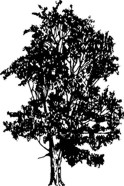|
SILVICS OF SUGAR MAPLE
(Acer saccharum Marsh.)
Common names:
- rock maple, hard maple
Field identification aids:
- new shoots are light brown or rust colored (red maple shoots are dark red)
- buds are opposite and sharp pointed (red maple has blunt buds that are much larger)
- leaf edge has fewer teeth than red maple leaves
- graceful branching (red maple branching is more irregular)
Average mature tree:
- 100 to 120 years old
- 24 m to 27 m (80' to 90') tall
- 30 cm to 60 cm (12" to 24") in diameter at
breast height
Maximum life span:
- 200 - 300 years
Shade tolerance:
- tolerant
Rooting:
- deep and wide-spreading
Windfirmness:
- windfirm
Reproduction:
- reproduces by seed, stump sprouting and to some extent root suckering
- tree may begin to produce seed when 40 to 60 years old, with full crop production after 70 to 100 years
- good seed crop production every 2 to 5 years
- best seed germination occurs on moist, mineral humus mixture
- has the unique ability to reproduce on undisturbed forest litter
Growing sites:
- range from well-drained to dry
- best growth is on deep fertile, well-drained moist loam soil
- usually found on well-drained upland soils
Associated species:
- usually found with beech, yellow birch, and red spruce on good sites
- occasionally found in pure stands
Principal damaging agents:
- sugar maple borer, gypsy moth, forest tent caterpillar, and fall cankerworm
Notes:
- sugar maple comprises 4.6% of the merchantable volume in Nova Scotia
- young shoots are heavily-browsed by deer
- best tree for producing maple syrup
- wood is excellent for flooring, furniture, interior finishing, veneers, sporting goods, and musical instruments
- a majestic shade tree
|


